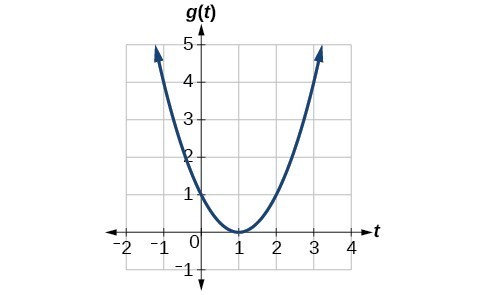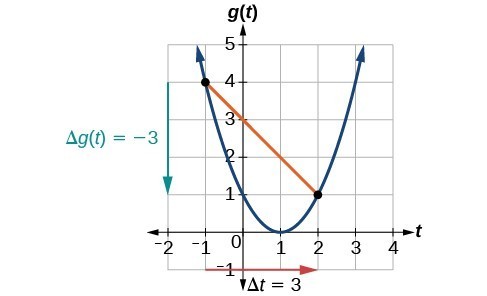What Is The Average Rate Of Change From X = 0 To X = 5?
|
| 2005 | 2006 | 2007 | 2008 | 2009 | 2010 | 2011 | 2012 |
|
| 2.31 | 2.62 | 2.84 | 3.xxx | 2.41 | two.84 | 3.58 | iii.68 |
The toll change per year is a rate of change considering it describes how an output quantity changes relative to the change in the input quantity. Nosotros can see that the price of gasoline in the table higher up did not change by the aforementioned amount each yr, and so the rate of change was not constant. If we use merely the beginning and ending data, we would be finding the average charge per unit of change over the specified period of fourth dimension. To find the average rate of modify, we divide the alter in the output value by the change in the input value.
Boilerplate rate of change=
=
=
=
The Greek letter of the alphabet
(delta) signifies the modify in a quantity; we read the ratio every bit "delta-y over delta-10" or "the change in
divided by the change in
." Occasionally we write
instead of
, which withal represents the alter in the office'due south output value resulting from a change to its input value. It does not mean we are changing the function into some other function.
In our example, the gasoline toll increased past $1.37 from 2005 to 2012. Over 7 years, the average rate of change was
On boilerplate, the price of gas increased by about 19.6¢ each year.
Other examples of rates of change include:
- A population of rats increasing by twoscore rats per calendar week
- A car traveling 68 miles per hour (distance traveled changes past 68 miles each hour every bit time passes)
- A car driving 27 miles per gallon (distance traveled changes by 27 miles for each gallon)
- The electric current through an electric circuit increasing by 0.125 amperes for every volt of increased voltage
- The amount of money in a college account decreasing past $4,000 per quarter
A Full general Notation: Rate of Change
A charge per unit of change describes how an output quantity changes relative to the change in the input quantity. The units on a charge per unit of alter are "output units per input units."
The average rate of change between two input values is the total change of the function values (output values) divided by the change in the input values.
How To: Given the value of a office at different points, calculate the average rate of change of a function for the interval betwixt 2 values
and
.
- Calculate the deviation
. - Calculate the difference
. - Find the ratio
.
Example 1: Computing an Average Rate of Modify
Using the information in the table below, find the average rate of change of the cost of gasoline betwixt 2007 and 2009.
|
| 2005 | 2006 | 2007 | 2008 | 2009 | 2010 | 2011 | 2012 |
|
| 2.31 | 2.62 | 2.84 | 3.30 | 2.41 | 2.84 | 3.58 | 3.68 |
Solution
In 2007, the price of gasoline was $ii.84. In 2009, the cost was $2.41. The average rate of change is
Analysis of the Solution
Notation that a decrease is expressed by a negative change or "negative increase." A rate of change is negative when the output decreases equally the input increases or when the output increases every bit the input decreases.
The post-obit video provides some other example of how to observe the boilerplate charge per unit of change between two points from a tabular array of values.
Endeavour It 1
Using the data in the table beneath, notice the average rate of change betwixt 2005 and 2010.
|
| 2005 | 2006 | 2007 | 2008 | 2009 | 2010 | 2011 | 2012 |
|
| 2.31 | two.62 | 2.84 | 3.30 | 2.41 | ii.84 | 3.58 | iii.68 |
Solution
Instance ii: Computing Average Charge per unit of Change from a Graph
Given the function
shown in Figure ane, find the average rate of change on the interval
.
 Effigy ane
Effigy ane
Solution
 Figure 2
Figure 2
At
, the graph shows
. At
, the graph shows
.
The horizontal change
is shown by the carmine arrow, and the vertical change
is shown by the turquoise pointer. The output changes by –3 while the input changes by 3, giving an average rate of change of
Assay of the Solution
Note that the order we choose is very important. If, for example, we use
, we will not get the right respond. Decide which point will be 1 and which point will be 2, and keep the coordinates stock-still as
and
.
Case 3: Calculating Average Rate of Change from a Table
Afterwards picking up a friend who lives 10 miles away, Anna records her altitude from abode over time. The values are shown in the tabular array below. Find her average speed over the first vi hours.
| t (hours) | 0 | ane | ii | 3 | four | 5 | half dozen | seven |
| D(t) (miles) | 10 | 55 | 90 | 153 | 214 | 240 | 282 | 300 |
Solution
Here, the average speed is the average rate of alter. She traveled 282 miles in half dozen hours, for an average speed of
The boilerplate speed is 47 miles per 60 minutes.
Analysis of the Solution
Because the speed is non abiding, the boilerplate speed depends on the interval chosen. For the interval [two,3], the average speed is 63 miles per hour.
Example iv: Computing Average Rate of Change for a Function Expressed as a Formula
Compute the boilerplate rate of change of
on the interval
Solution
We can start by computing the function values at each endpoint of the interval.
Now we compute the average charge per unit of change.
The following video provides another example of finding the average rate of change of a function given a formula and an interval.
Try Information technology 2
Find the boilerplate rate of change of
on the interval
.
Solution
Example 5: Finding the Average Rate of Change of a Force
The electrostatic forcefulness
, measured in newtons, betwixt two charged particles can be related to the altitude between the particles
, in centimeters, past the formula
. Find the average rate of change of force if the altitude between the particles is increased from 2 cm to 6 cm.
Solution
We are computing the average charge per unit of change of
on the interval
.
The average charge per unit of change is
newton per centimeter.
Example vi: Finding an Average Rate of Modify as an Expression
Find the average rate of change of
on the interval
. The reply will be an expression involving
.
Solution
Nosotros apply the average charge per unit of change formula.
.
=
=
=
This consequence tells the states the average rate of modify in terms of
between
and any other betoken
. For example, on the interval
, the average rate of alter would be
.
Try It 3
Observe the boilerplate rate of change of
on the interval
.
Solution
Licenses and Attributions
Source: https://courses.lumenlearning.com/ivytech-collegealgebra/chapter/find-the-average-rate-of-change-of-a-function/
Posted by: chavezhond1975.blogspot.com

0 Response to "What Is The Average Rate Of Change From X = 0 To X = 5?"
Post a Comment